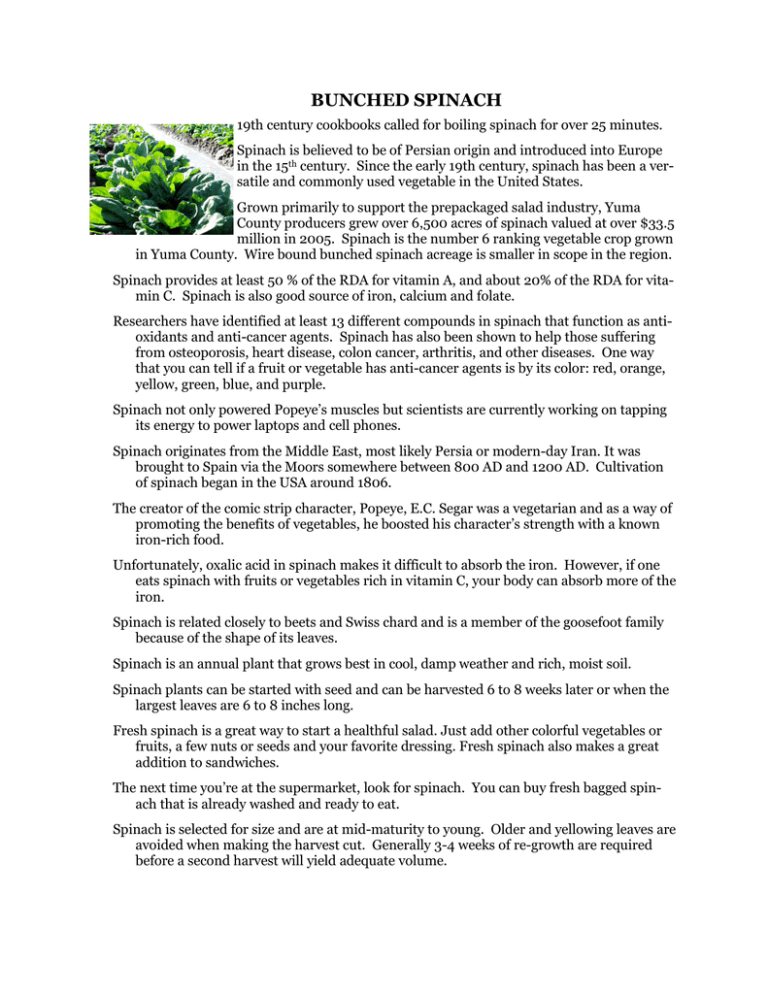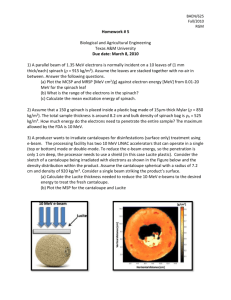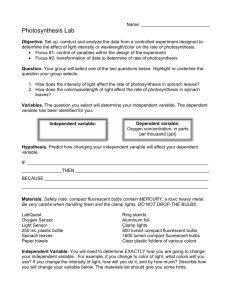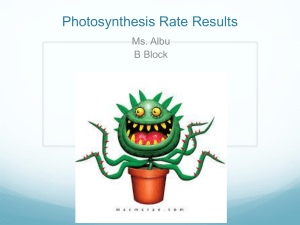BUNCHED SPINACH
advertisement

BUNCHED SPINACH 19th century cookbooks called for boiling spinach for over 25 minutes. Spinach is believed to be of Persian origin and introduced into Europe in the 15th century. Since the early 19th century, spinach has been a versatile and commonly used vegetable in the United States. Grown primarily to support the prepackaged salad industry, Yuma County producers grew over 6,500 acres of spinach valued at over $33.5 million in 2005. Spinach is the number 6 ranking vegetable crop grown in Yuma County. Wire bound bunched spinach acreage is smaller in scope in the region. Spinach provides at least 50 % of the RDA for vitamin A, and about 20% of the RDA for vitamin C. Spinach is also good source of iron, calcium and folate. Researchers have identified at least 13 different compounds in spinach that function as antioxidants and anti-cancer agents. Spinach has also been shown to help those suffering from osteoporosis, heart disease, colon cancer, arthritis, and other diseases. One way that you can tell if a fruit or vegetable has anti-cancer agents is by its color: red, orange, yellow, green, blue, and purple. Spinach not only powered Popeye’s muscles but scientists are currently working on tapping its energy to power laptops and cell phones. Spinach originates from the Middle East, most likely Persia or modern-day Iran. It was brought to Spain via the Moors somewhere between 800 AD and 1200 AD. Cultivation of spinach began in the USA around 1806. The creator of the comic strip character, Popeye, E.C. Segar was a vegetarian and as a way of promoting the benefits of vegetables, he boosted his character’s strength with a known iron-rich food. Unfortunately, oxalic acid in spinach makes it difficult to absorb the iron. However, if one eats spinach with fruits or vegetables rich in vitamin C, your body can absorb more of the iron. Spinach is related closely to beets and Swiss chard and is a member of the goosefoot family because of the shape of its leaves. Spinach is an annual plant that grows best in cool, damp weather and rich, moist soil. Spinach plants can be started with seed and can be harvested 6 to 8 weeks later or when the largest leaves are 6 to 8 inches long. Fresh spinach is a great way to start a healthful salad. Just add other colorful vegetables or fruits, a few nuts or seeds and your favorite dressing. Fresh spinach also makes a great addition to sandwiches. The next time you’re at the supermarket, look for spinach. You can buy fresh bagged spinach that is already washed and ready to eat. Spinach is selected for size and are at mid-maturity to young. Older and yellowing leaves are avoided when making the harvest cut. Generally 3-4 weeks of re-growth are required before a second harvest will yield adequate volume. Spinach, whether bunched or as leaves, should be uniformly green (generally not yellowgreen), fully turgid, fairly clean, and free from serious damage. For bunched spinach, roots should be trimmed short to grade standards and petioles should be predominantly shorter than the leaf blade. Spinach is highly perishable and will not maintain good quality for more than 2 weeks. Wilting, yellowing of leaves, and decay are likely to increase following storage beyond 10-14 days; faster at common distribution conditions of 41 to 50°F. Birds Eye was the first company to advertise “frozen spinach” in the edition of the 1949 Life Magazine. The advertisement depicted a pretty woman, wearing pearls, reading a book and having a cup of coffee. She had time to do this because the Birds Eye spinach was cleaned, cut and ready for heating. Bon Appetite Magazine conducted their annual poll in March, 2005 and 56% responded that spinach is their favorite vegetable. According to New York Newsday (April, 2005), teenagers consume the least amount of spinach. Women consume 2.5 pounds per capita annually compared with 2.2 pounds per capita for men annually. On average, each American eats 3 pounds of spinach a year, according to the USDA: 2 pounds of fresh spinach and 1 pound of processing spinach. Consumption has risen steadily, especially for fresh spinach. There are three types of spinach available in U.S. supermarkets: savoy (curly leaf), flat (smooth leaf) and semi-savoy (slightly curly leaves). The savoy has dark green crinkly leaves while the flat variety matches its name. The spade shaped leaves are flat leaves and have a milder taste than the savoy. The semi-savoy leaves are slightly curly. Baby spinach comes from the smallest leaves of flat leaf spinach varieties. Kurt Nolte is an area agriculture agent with the Yuma County Cooperative Extension. He can be reached at 928-726-3904.




